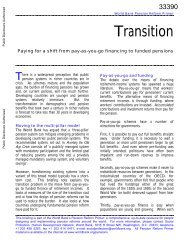Financial Sector Development in Africa: Opportunities ... - World Bank
Financial Sector Development in Africa: Opportunities ... - World Bank
Financial Sector Development in Africa: Opportunities ... - World Bank
You also want an ePaper? Increase the reach of your titles
YUMPU automatically turns print PDFs into web optimized ePapers that Google loves.
F<strong>in</strong>anc<strong>in</strong>g Agriculture: Selected Approaches for the Engagement of Commercial F<strong>in</strong>ance 93<br />
• The <strong>in</strong>termediary firms are much better placed to make sure that the<br />
f<strong>in</strong>ance is spent by the borrower on productive <strong>in</strong>puts rather than<br />
diverted <strong>in</strong>to activities that may not realize repayment.<br />
• The f<strong>in</strong>ance is a real trad<strong>in</strong>g advantage to the <strong>in</strong>termediary firm and can<br />
be used to solidify current bank<strong>in</strong>g relationships or to attract new customers<br />
from competitors.<br />
Supplier versus buyer f<strong>in</strong>ance. There are subtle differences between the<br />
transactional structures, which present different risk profiles for each of<br />
the transactions. In supplier f<strong>in</strong>ance, the producer undertakes to sell produce<br />
to the buyer <strong>in</strong> return for the provision of credit to pref<strong>in</strong>ance<br />
production. Assum<strong>in</strong>g the producer fulfills this promise, the buyer is then<br />
<strong>in</strong> a very good condition to control repayment, which is a positive feature.<br />
Usually the buyer will deduct the costs of the loan directly from the payment<br />
due to the producer, who will receive the balance. However, this<br />
positive feature can be underm<strong>in</strong>ed by poor bus<strong>in</strong>ess relationships and<br />
behavior between the parties. Side-sell<strong>in</strong>g occurs where producers breach<br />
their promise to the buyer to sell an agreed amount and quality of produce<br />
at a predeterm<strong>in</strong>ed rate <strong>in</strong> favor of other buyers who may be offer<strong>in</strong>g<br />
a better market rate at the time the produce is ready to sell. This<br />
behavior can be exacerbated by buyers who renege on price promises (or<br />
manipulate the overall amount due to the producer) and contribute to a<br />
breakdown <strong>in</strong> trust. In this circumstance, the buyers lose control of the<br />
source of repayment to the risk of both themselves and the f<strong>in</strong>ancier.<br />
Alternatively, <strong>in</strong>put suppliers are <strong>in</strong> an excellent position to ensure<br />
that the funds advanced are spent on agricultural <strong>in</strong>puts rather than<br />
diverted to other, potentially nonproductive, activities. However, they<br />
have less control over the ultimate source of repayment. Both buyer and<br />
supplier f<strong>in</strong>ance arrangements rely on stable and professional relationships<br />
between producers and <strong>in</strong>termediary firms. To some extent it is<br />
beneficial if the <strong>in</strong>termediary firms are <strong>in</strong> a position of relative market<br />
power to the producer, and the practical sanctions for breach of loan<br />
covenants (for example, difficulty <strong>in</strong> sourc<strong>in</strong>g alternative suppliers or<br />
buyers) for the producer are clear. This sort of sanction is usually more<br />
obvious to producers than the more ambiguous threats of legal action <strong>in</strong><br />
costly and <strong>in</strong>effective legal systems.<br />
In some circumstances, <strong>in</strong>termediaries have the best of both worlds and<br />
are able to practically control repayment, as well as ensure that the credit<br />
is spent on the required <strong>in</strong>put supplies. Contract farm<strong>in</strong>g operations and<br />
outgrower schemes—bus<strong>in</strong>ess relationships <strong>in</strong> which the buyer provides







